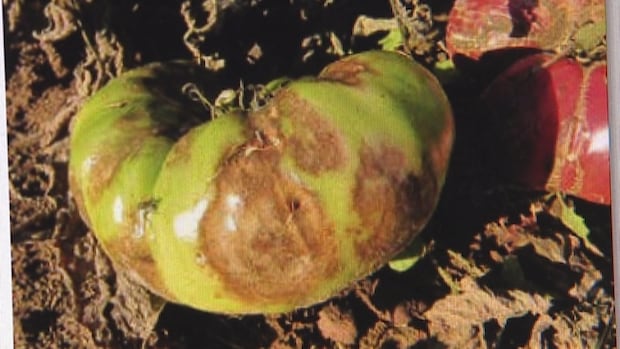New strains of late blight are targeting tomatoes, and while the disease is not yet known to be on Prince Edward Island, a researcher is warning home gardeners in the province that “it’s not the kind of disease you can ever drop your guard on.”
Late blight disfigures and destroys solanaceous (or nightshade) crops like potatoes, tomatoes, peppers and eggplants. A fungus-like micro-organism called Phytophthora infestans causes brown spots to appear, eventually leading the crops to rot.
Dr. Rick Peters, a P.E.I.-based research scientist with Agriculture and Agri-Food Canada, said researchers have found several new strains of the disease across Canada. The strain US-23 was the only one collected so far from Eastern Canada, primarily in a 2019-2021 study his team worked on.
“US-23 is actually very aggressive on tomatoes, and home gardeners can be a source of disease for commercial potato crops if they’re not managing the disease in their gardens,” Peters said. “We’ve seen that happen a number of times.”
Late blight thrives in cool, moist weather. Due to climate change gradually turning up summer temperatures on P.E.I., the province has not seen many cases of the disease in several years.
The disease can quickly cause a lot of damage when it does set in, though.
 Late blight is ‘very aggressive and does result in some extreme measures to manage it,’ says Dr. Rick Peters, a P.E.I.-based research scientist of Agriculture and Agri-Food Canada. (Delaney Kelly CBC )
Late blight is ‘very aggressive and does result in some extreme measures to manage it,’ says Dr. Rick Peters, a P.E.I.-based research scientist of Agriculture and Agri-Food Canada. (Delaney Kelly CBC )
“It is very aggressive and does result in some extreme measures to manage it — sometimes killing an area around the first find. Sometimes even entire fields have been killed,” Peters said.
Once the disease has set in, it is too late to save the crop, as the people of Ireland learned in the 1840s when late blight destroyed successive years of potato plantings and kicked off a famine that killed an estimated one million people.
LISTEN: CBC Radio documentary about the consequences of the Irish potato famine
Sunday EditionThe Great Hunger
As a set-up for next week’s program about the 1916 Easter Rising, historian Mary Daly explains the devastating toll of the Irish potato famine in the 1840s.
That makes prevention measures that much more important.
To prevent the disease, home tomato gardeners can plant varieties that are resistant to late blight, which can be found at local nurseries and box stores.
For those who wish to grow varieties susceptible to late blight, Peters advises paying close attention to the plants. If any characteristic spots appear, gardeners should remove those plants immediately and put them in a plastic bag for disposal in the black garbage bin.
Sometimes we’ve even monitored spores moving up the Eastern Seaboard on storm systems, so they can actually travel a fair distance.— Dr. Rick Peters
Getting rid of infected plants in compost bins risks the plants releasing spores as they die, causing the problem to spread.
“Home gardeners are becoming an important part of the whole late blight epidemiology across the country, and in fact across the continent,” Peters said.
‘We still have to be vigilant’
As for commercial potato growers on P.E.I., Peters said a variety of tools are used to manage the disease, including traps that give early warning of spores in the air, as well as a fungicide program and forecasting models to predict the chance of blight conditions.
Produce, like this potato, infected with late blight is not harmful if ingested but can disfigure and reduce the yield of crops — something the commercial industry would like to prevent. (Submitted by Agriculture and Agri-Food Canada)
“We really haven’t had to deal with late blight, fortunately, over the last number of years, although it’s kind of a double-edged sword… because it is hotter and drier. So there’s been more pressure on the crop being stressed with lack of moisture,” Peters said.
“We still have to be vigilant because if we do get those cooler nights with dews in the morning, it can still be conducive to blight development, especially if there’s spores in the area.”
Spores are known to spread by rain and wind, allowing infected plants to pass late blight on to their neighbours and surrounding area.
“Sometimes we’ve even monitored spores moving up the Eastern Seaboard on storm systems, so they can actually travel a fair distance,” said Peters.
“Home gardeners, if they do have infected plants — tomatoes or potatoes — can then of course be a source of these spores moving into the potato crop.”
‘A biological indicator of climate change’
While the province has mostly been spared from late blight, Peters said other diseases that used to impact predominantly Western Canada are finding their way to P.E.I.’s crops because of the drier weather.
Two such are early blight and brown spot.
“It’s kind of a biological indicator of climate change that we see the shift in the disease profile,” Peters said.
But he said these diseases do not cause as much harm as late blight and the province has appropriate measures in place to handle them.


Comments are closed.